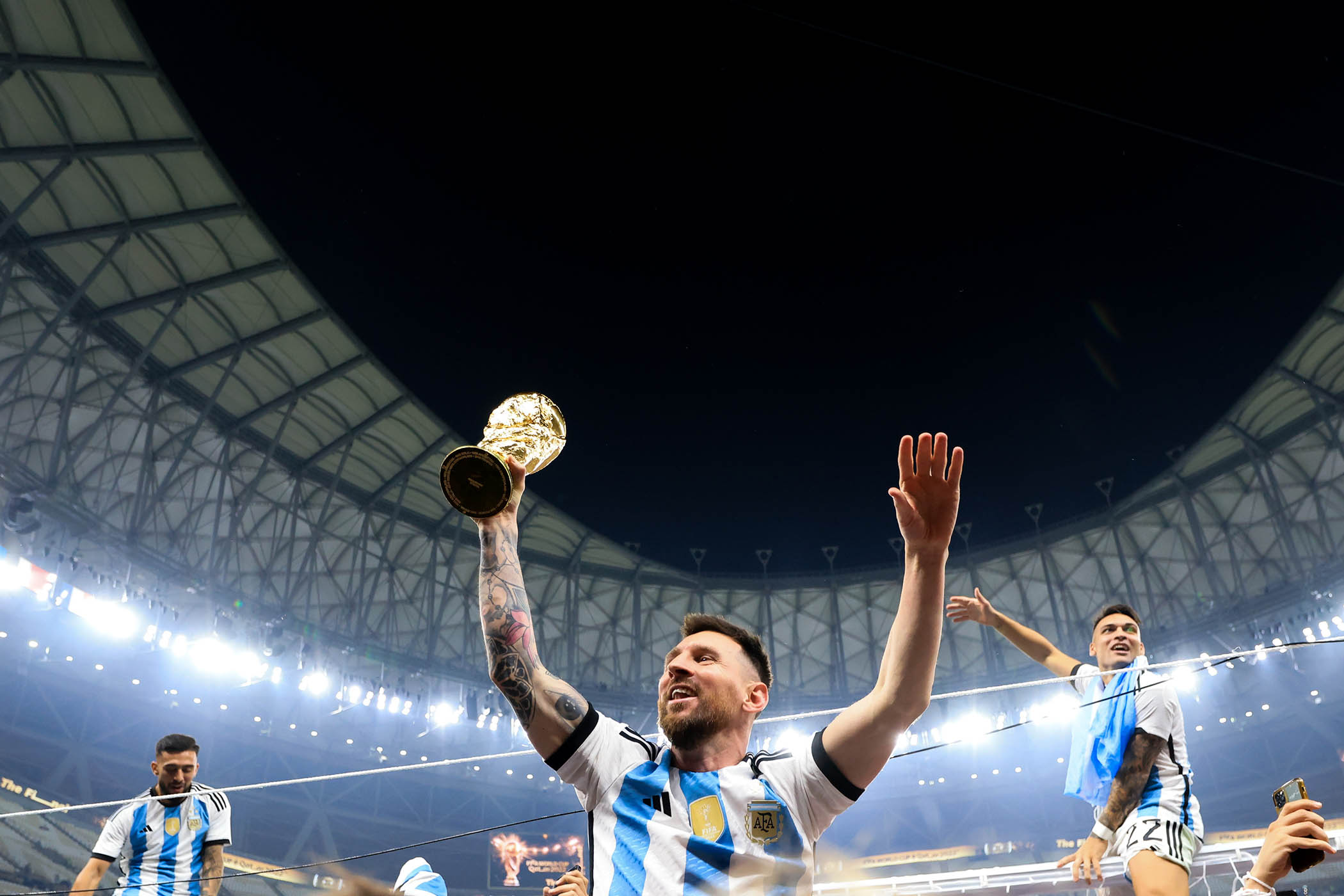There were times, in the years between 2010 and 2022, when I didn’t quite understand the point of the 2022 World Cup. As a sporting event, of course, it made complete sense. Like many sport lovers, my subconscious places each year into a distinct category: Olympics, World Cup (men’s), World Cup (women’s) or fallow.
As a political project, though, the 2022 World Cup appeared to be astonishingly ill-judged. In 2010, world football’s governing body, Fifa, voted to hand the jewel in its crown – the men’s World Cup, a global mega-event – to Qatar, an impossibly wealthy Gulf microstate just a little smaller than Yorkshire.
To make it happen, in the space of just a dozen years Qatar had to build not just the necessary stadiums to host the games, but also various training facilities, several neighbourhoods, a whole metro network and seemingly an entire city.
The ever-expanding scale of a modern World Cup is one of the central themes of Jonathan Wilson’s The Power and the Glory and Simon Kuper’s World Cup Fever: as Kuper recalls, even a tournament as recent as 1990’s in Italy felt like a “village fete” compared with the absurd extremities of Qatar. Most estimates suggest that the 2020 competition cost in the region of £200bn.
Qatar has always strenuously denied any wrongdoing in the selection process, in which Fifa member nations vote to decide between potential host bids. But there was enough scepticism that, five years after Fifa awarded the tournament to Qatar, the US Department of Justice launched a raid on the Baur au Lac hotel in Zurich, a favoured haunt of Fifa’s executive body. A hailstorm of indictments followed.
There was more. Fifa’s own initial research had indicated that Qatar, where temperatures reach more than 40C in the summer, was far too hot to host a summer World Cup. The country’s authorities, having initially insisted they would have air-conditioned stadiums, then changed their minds and set to work persuading Fifa to rearrange the entire global football calendar for two years.
Their reward was nothing but criticism. Quite a lot of it was justified. Qatar was not just assailed with allegations of corruption but stained by its treatment of the millions of migrant workers who built the World Cup infrastructure, its repressive laws governing homosexuality and its treatment of women.
The strange mix of Qatari plutocrats and western apparatchiks working on the bid dismissed all of this as unfair. At times they adopted the line that the World Cup was a chance to modernise Qatar; they railed against what they saw – not always illegitimately – as the condescension of the self-satisfied, hypocritical, colonialist west. (The PR firms Qatar had to hire to make this argument do not come cheap.)
The staging of the tournament is now a nakedly political act, an instrument of policy
As someone tasked with picking their way through this morass (as then chief soccer correspondent of the New York Times), it was quite hard to understand the Qataris’ strategy. The project was designed to turn Qatar into a player on the global stage, but it seemed to involve a critical mass of reputational damage.
By 18 December 2022, however, almost 12 years to the day after Qatar was awarded the tournament, it became very obvious that I was wrong. Much of that World Cup, looking back now, feels uncanny. All month, ghostly music drifted through the streets of Msheireb, the downtown district purpose-built for the tournament. The Qatari national team was followed by fervent supporters who had, it turned out, been recruited from Lebanon.
The souk (the traditional marketplace) that became the tournament’s heart had been rebuilt on the site of the actual souk because, it had been decided, the old version did not look souk-y enough. Lusail, the city built to host the final, was really just a single boulevard, a Potemkin place, with a giant neon shark floating at one end.
But the Argentina-France final – the culmination not just of the tournament but of all that Qatar had done to become the centre of the world on that day – stands in the sharpest possible relief. It’s not just that the game, won on penalties by Argentina, was possibly the best World Cup final of all time. It’s that it seems inevitable that it will come to be seen as the zenith of football’s golden age – when a simple sport grew to become the greatest cultural phenomenon the world has ever known.
It was in Qatar that Lionel Messi at last won the one trophy that had eluded him throughout his glorious career, cementing his status as the finest player of all time. He did so in a gleaming golden bowl of a stadium, an arena so large that its far side seemed to be lost in the haze, in front of tens of thousands of delirious, weeping Argentinians who had travelled halfway across the world. And when Messi did eventually lift the World Cup, he did so with a bisht, a traditional Qatari cloak, draped across his shoulders – as if anyone was in any doubt that this had been a political event as much as a sporting one. This was the moment that Qatar, as much as Argentina, won.
That the World Cup has become a tool for the acquisition and exercise of power is obvious. But football has never been especially good at curating its own history, or at least not quite as good as its peers: NFL Films was documenting American football in a martial, cinematic style almost from the league’s inception in 1920. For all its popularity, football seemed careless not just of its past but its broader significance as a window through which to see the world. It was as though the sport on some level felt itself to be low culture, inherently disposable.
Over the years, a handful of journalists have challenged this assumption: James Catton, Charles Buchan, The Observer’s own Hugh McIlvanney and, prime among them, Brian Glanville. To call Glanville, who died earlier this year, a football writer does not quite go far enough. Better instead to think of him as a keeper of the game’s history.
Glanville first published what would become The Story of the World Cup in 1973; he would update it every few years to include subsequent tournaments (from an author’s point of view, it’s necessary at this juncture to say: “Fair play, Brian”). It is no exaggeration to say that we know certain elements of the game’s past only because Glanville was there; we see some of its history largely through his eyes.
Seminal though his work was, it remained unapologetically rooted in football. He tells us what happened at each World Cup, and paints a portrait of the teams and players that defined them, vividly capturing the sensation of victory and defeat; only rarely does he seek to place a tournament in its non-sporting context.
Wilson and Kuper have shouldered the burden of filling that gap, of treating the World Cup not as a month-long sporting festival but as a way, as Kuper puts it, to “illuminate” the world.
The pair are well qualified: Wilson is the game’s pre-eminent popular historian; Kuper’s 1994 book, Football Against the Enemy, essentially invented the genre of football as sociology. His breezy, magazine-style prose proved perfect for making the game palatable to the literati. That both have published World Cup histories in ample time for the 2026 tournament in the US is in itself a pretty good illustration of what a seismic cultural event the tournament has become.
Wilson’s effort illustrates this more effectively. His 2008 book Inverting the Pyramid might have earned him a not entirely inaccurate reputation as a tactics nerd, but he is at his most compelling when writing about Viennese cafe society or the brutality of the Argentine military junta. The Power and the Glory is a history book with occasional tangents about overlapping left-backs. World Cup Fever, by contrast, is more personal, based largely on Kuper’s experiences covering tournaments for the Financial Times. His work, in whatever oeuvre, is never less than readable, but the bird’s-eye perspective is more useful in examining the way the World Cup has always, as Wilson writes, played “a role in nation building”.
There are plenty of examples of this scattered through both books. The clearest is West Germany, whose victory against Hungary in Switzerland in 1954, the horrors of the war still fresh, came to be used as a central part of the country’s “foundation myth”. Kuper cites the historian Joachim Fest, who placed the German footballer Fritz Walter – the central figure in what became known as the “miracle of Bern” – alongside the politician Konrad Adenauer and the economist Ludwig Erhard as one of the Federal Republic’s “three founding fathers”.
The mounting awareness over the past 30 years or so that the World Cup has “dramatised certain themes of the modern world”, as Kuper puts it, leads directly to the World Cup being held in Qatar, with its golden stadiums and ersatz souk.
Conscious attempts to harness the tournament’s power by autocrats – Mussolini, Putin – have had a distortive effect: the significance of the World Cup is no longer all about the country that wins (or loses) it, but rather what it says about the country where it is held.
The staging of the tournament is now a nakedly political act, an instrument of policy, one that has left its legacy in the form of expensive, unwanted stadiums in Russia, South Africa and Brazil – where one arena, as Wilson points out, ended up becoming a bus depot – and, more striking still, a whole cityscape in Qatar. I often think of what happened to that neon shark.
“The World Cup represents the world as it is, not as those who run it would wish it to be,” Kuper writes. That was true, once. It is not any more, now those two things increasingly appear to be exactly the same.
World Cup Fever by Simon Kuper (Profile Books Ltd, £20). Order a copy at observershop.co.uk for £17. Delivery charges may applyThe Power and the Glory: A New History of the World Cup by Jonathan Wilson (Abacus, £25). Order a copy at observershop.co.uk for £22.50. Delivery charges may apply
Photograph by Getty Images

